Preparation of High-Performance Transparent Al2O3 Dielectric Films via Self-Exothermic Reaction Based on Solution Method and Applications
Abstract
:1. Introduction
2. Experiment
2.1. Synthesis of Precursor Solution
2.2. Dielectric Film Fabrication
2.3. MIM Device Fabrication
3. Result and Discussion
3.1. Surface Tension Tests Results
3.2. TG-DSC Test Analysis
3.3. Surface Morphology Analysis
3.4. Thin Film Thickness Measurement
3.5. Transmittance Test
3.6. Leakage Current Density Analysis
3.7. Capacitance Density Analysis
4. Conclusions
Author Contributions
Funding
Data Availability Statement
Acknowledgments
Conflicts of Interest
References
- Yi, Z.; Lyu, B.; Gao, D.; Hao, J.; Liu, Z.; Ning, Z.; Jiang, B. Preparation Strategy and Composition Design of Polymer-Based Layered Composites for Improving Energy Storage Performances. J. Energy Storage 2024, 92, 111995. [Google Scholar] [CrossRef]
- Huan, T.D.; Boggs, S.; Teyssedre, G.; Laurent, C.; Cakmak, M.; Kumar, S.; Ramprasad, R. Advanced Polymeric Dielectrics for High Energy Density Applications. Prog. Mater. Sci. 2016, 83, 236–269. [Google Scholar] [CrossRef]
- Yao, Z.; Song, Z.; Hao, H.; Yu, Z.; Cao, M.; Zhang, S.; Lanagan, M.T.; Liu, H. Homogeneous/Inhomogeneous-Structured Dielectrics and Their Energy-Storage Performances. Adv. Mater. 2017, 29, 1601727. [Google Scholar] [CrossRef] [PubMed]
- Mukherjee, A.; Nagaria, R.K. A Comparative Study of Various High-K Dielectric Materials as Gate Oxide Layer on TG FinFET. In Proceedings of the 2021 2nd Global Conference for Advancement in Technology (GCAT), Bangkok, Thailand, 1–3 October 2021; pp. 1–4. [Google Scholar] [CrossRef]
- Han, D.; Geng, Y.; Cai, J.; Wang, W.; Wang, L.; Tian, Y.; Wang, Y.; Liu, L.; Zhang, S. Reliability Study of Zinc Oxide Thin-Film Transistor with High-K Gate Dielectric. In Proceedings of the 2012 IEEE International Conference on Electron Devices and Solid State Circuit (EDSSC), Bangkok, Thailand, 3–5 December 2012; pp. 1–2. [Google Scholar] [CrossRef]
- Gao, H.-X.; Hu, R.; Yang, Y.-T. The Theoretical Investigation and Analysis of High-Performance ZnO Double-Gate Double-Layer Insulator Thin-Film Transistors. Chin. Phys. Lett. 2012, 29, 017305. [Google Scholar] [CrossRef]
- Xie, J.; Zhu, Z.; Tao, H.; Zhou, S.; Liang, Z.; Li, Z.; Yao, R.; Wang, Y.; Ning, H.; Peng, J. Research Progress of High Dielectric Constant Zirconia-Based Materials for Gate Dielectric Application. Coatings 2020, 10, 698. [Google Scholar] [CrossRef]
- Robertson, J. High Dielectric Constant Oxides. Eur. Phys. J. Appl. Phys 2004, 28, 265–291. [Google Scholar] [CrossRef]
- Wang, Y.; Han, T.; Yang, L.; Wang, B.; Xue, J.; Yi, S.; Xie, A.; Cao, C. A Novel IGZO-TFT Device With High Dielectric Constant Sandwich Structure Gate Dielectric Layer. In Proceedings of the 2023 24th International Conference on Electronic Packaging Technology (ICEPT), Shihezi City, China, 8–11 August 2023; pp. 1–5. [Google Scholar] [CrossRef]
- Shrivastava, S.; Bahubalindruni, P.G.; Goes, J. A Pulse Width Modulator Using a High-Speed Comparator With Flexible Oxide TFT Technology. IEEE Solid-State Circuits Lett. 2022, 5, 288–291. [Google Scholar] [CrossRef]
- Deng, X.; Zhang, Y.; Fu, H.; Zhang, S. High Mobility Metal-Oxide Thin Film Transistors with IGZO/In2O3 Dual-Channel Structure. In Proceedings of the 2018 9th Inthernational Conference on Computer Aided Design for Thin-Film Transistors (CAD-TFT), Shenzhen, China, 16–18 November 2018; pp. 1–3. [Google Scholar] [CrossRef]
- Yang, Z.; Pu, H.; Cui, C.; Zhang, L.; Dong, C.; Zhang, Q. Solution-Processed Indium–Zinc-Oxide Thin Film Transistors With High- k Magnesium Titanium Oxide Dielectric. IEEE Electron. Device Lett. 2014, 35, 557–559. [Google Scholar] [CrossRef]
- Wang, B.; Huang, W.; Chi, L.; Al-Hashimi, M.; Marks, T.J.; Facchetti, A. High-k Gate Dielectrics for Emerging Flexible and Stretchable Electronics. Chem. Rev. 2018, 118, 5690–5754. [Google Scholar] [CrossRef]
- Devaray, P.; Hatta, S.F.W.M.; Wong, Y.H. An Overview of Conventional and New Advancements in High Kappa Thin Film Deposition Techniques in Metal Oxide Semiconductor Devices. J. Mater. Sci. Mater. Electron. 2022, 33, 7313–7348. [Google Scholar] [CrossRef]
- Johnson, R.W.; Hultqvist, A.; Bent, S.F. A Brief Review of Atomic Layer Deposition: From Fundamentals to Applications. Mater. Today 2014, 17, 236–246. [Google Scholar] [CrossRef]
- Christen, H.M.; Eres, G. Recent Advances in Pulsed-Laser Deposition of Complex Oxides. J. Phys. Condens. Matter 2008, 20, 264005. [Google Scholar] [CrossRef]
- Joung, S.-Y.; Yim, H.; Lee, D.; Shim, J.; Yoo, S.Y.; Kim, Y.H.; Kim, J.S.; Kim, H.; Hyeong, S.-K.; Kim, J.; et al. All-Solution-Processed High-Performance MoS2 Thin-Film Transistors with a Quasi-2D Perovskite Oxide Dielectric. ACS Nano 2024, 18, 1958–1968. [Google Scholar] [CrossRef] [PubMed]
- Jaehnike, F.; Pham, D.V.; Anselmann, R.; Bock, C.; Kunze, U. High-Quality Solution-Processed Silicon Oxide Gate Dielectric Applied on Indium Oxide Based Thin-Film Transistors. ACS Appl. Mater. Interfaces 2015, 7, 14011–14017. [Google Scholar] [CrossRef] [PubMed]
- Ji, S.-B.; Seong, N.; Park, J.; Im, H.; Kim, Y.-S.; Hong, Y. Field-Effect Mobility Extraction of Solution-Processed InGaZnO Thin-Film Transistors Considering Dielectric Dispersion Behavior of AlOx Gate Insulator. ACS Appl. Electron. Mater. 2023, 5, 1035–1040. [Google Scholar] [CrossRef]
- He, W.; Wang, S.; Hang, B.; Wei, X.; Liang, L. Development of Solution-Processed Organic Semiconductor Thin Films. In Interdisciplinary Research for Printing and Packaging; Zhao, P., Ye, Z., Xu, M., Yang, L., Zhang, L., Yan, S., Eds.; Springer Singapore: Singapore, 2022; pp. 471–479. [Google Scholar] [CrossRef]
- Liu, Q.; Zhao, C.; Zhao, T.; Liu, Y.; Mitrovic, I.Z.; Xu, W.; Yang, L.; Zhao, C.Z. Ecofriendly Solution-Combustion-Processed Thin-Film Transistors for Synaptic Emulation and Neuromorphic Computing. ACS Appl. Mater. Interfaces 2021, 13, 18961–18973. [Google Scholar] [CrossRef]
- Quah, H.J.; Cheong, K.Y.; Hassan, Z.; Lockman, Z.; Jasni, F.A.; Lim, W.F. Effects of Postdeposition Annealing in Argon Ambient on Metallorganic Decomposed CeO2 Gate Spin Coated on Silicon. J. Electrochem. Soc. 2009, 157, H6. [Google Scholar] [CrossRef]
- Xu, W.; Long, M.; Zhang, T.; Liang, L.; Cao, H.; Zhu, D.; Xu, J.-B. Fully Solution-Processed Metal Oxide Thin-Film Transistors via a Low-Temperature Aqueous Route. Ceram. Int. 2017, 43, 6130–6137. [Google Scholar] [CrossRef]
- Jo, J.-W.; Kim, K.-H.; Kim, J.; Ban, S.G.; Kim, Y.-H.; Park, S.K. High-Mobility and Hysteresis-Free Flexible Oxide Thin-Film Transistors and Circuits by Using Bilayer Sol–Gel Gate Dielectrics. ACS Appl. Mater. Interfaces 2018, 10, 2679–2687. [Google Scholar] [CrossRef]
- Wang, S.; Yao, S.; Lin, J.; Xia, G. Eco-Friendly, Low-Temperature Solution Production of Oxide Thin Films for High-Performance Transistors via Infrared Irradiation of Chloride Precursors. Ceram. Int. 2019, 45, 9829–9834. [Google Scholar] [CrossRef]
- Arias, A.C.; MacKenzie, J.D.; McCulloch, I.; Rivnay, J.; Salleo, A. Materials and Applications for Large Area Electronics: Solution-Based Approaches. Chem. Rev. 2010, 110, 3–24. [Google Scholar] [CrossRef] [PubMed]
- Jung, Y.; Jun, T.; Kim, A.; Song, K.; Yeo, T.H.; Moon, J. Direct Photopatternable Organic–Inorganic Hybrid Gate Dielectric for Solution-Processed Flexible ZnO Thin Film Transistors. J. Mater. Chem. 2011, 21, 11879–11885. [Google Scholar] [CrossRef]
- Hwang, J.; Lee, J.; Kim, Y.; Lee, E.; Wang, Y.; Kim, H. Hybrid Gate Insulator for OTFT Using Dip-Coating Method. Curr. Appl. Phys. 2011, 11, S154–S157. [Google Scholar] [CrossRef]
- Wong, H.-S.P.; Lee, H.-Y.; Yu, S.; Chen, Y.-S.; Wu, Y.; Chen, P.-S.; Lee, B.; Chen, F.T.; Tsai, M.-J. Metal-Oxide RRAM. Proc. IEEE 2012, 100, 1951–1970. [Google Scholar] [CrossRef]
- El-Shereafy, E.; Abousekkina, M.M.; Mashaly, A.; El-Ashry, M. Mechanism of Thermal Decomposition and γ-Pyrolysis of Aluminum Nitrate Nonahydrate [Al(NO3)3·9H2O]. J. Radioanal. Nucl. Chem. 1998, 237, 183–186. [Google Scholar] [CrossRef]
- Melnikov, P.; Nascimento, V.A.; Arkhangelsky, I.V.; Zanoni Consolo, L.Z. Thermal Decomposition Mechanism of Aluminum Nitrate Octahydrate and Characterization of Intermediate Products by the Technique of Computerized Modeling. J. Therm. Anal. Calorim. 2013, 111, 543–548. [Google Scholar] [CrossRef]
- Mandai, T.; Johansson, P. Haloaluminate-Free Cationic Aluminum Complexes: Structural Characterization and Physicochemical Properties. J. Phys. Chem. C 2016, 120, 21285–21292. [Google Scholar] [CrossRef]
- Jung, S.H.; Han, H.S.; Kim, Y.B.; Kim, D.S.; Deshpande, N.G.; Oh, S.J.; Choi, J.H.; Cho, H.K. Toward Ultraviolet Solution Processed ZrOx/IZO Transistors with Top-Gate and Dual-Gate Operation: Selection of Solvents, Precursors, Stabilizers, and Additive Elements. J. Alloys Compd. 2020, 847, 156431. [Google Scholar] [CrossRef]
- Padhi, P.S.; Ajimsha, R.S.; Chetia, S.K.; Das, A.K.; Sahu, V.K.; Misra, P. Reduced Leakage Current in Al2O3/TiO2/Al2O3 Dielectric Stacks Grown by Pulsed Laser Deposition. AIP Conf. Proc. 2020, 2265, 030190. [Google Scholar] [CrossRef]
- Kwak, H.Y.; Kwon, H.M.; Kwon, S.K.; Jang, J.H.; Sung, S.Y.; Lim, S.; Lee, H.D. Dielectric Relaxation and Reliability of Al2O3-HfO2-Al2O3 Sandwiched Metal-Insulator-Metal (MIM) Capacitor. AMR 2013, 658, 116–119. [Google Scholar] [CrossRef]
- Choi, C.H.; Kim, T.; Ueda, S.; Shiah, Y.-S.; Hosono, H.; Kim, J.; Jeong, J.K. High-Performance Indium Gallium Tin Oxide Transistors with an Al2O3 Gate Insulator Deposited by Atomic Layer Deposition at a Low Temperature of 150 °C: Roles of Hydrogen and Excess Oxygen in the Al2O3 Dielectric Film. ACS Appl. Mater. Interfaces 2021, 13, 28451–28461. [Google Scholar] [CrossRef] [PubMed]

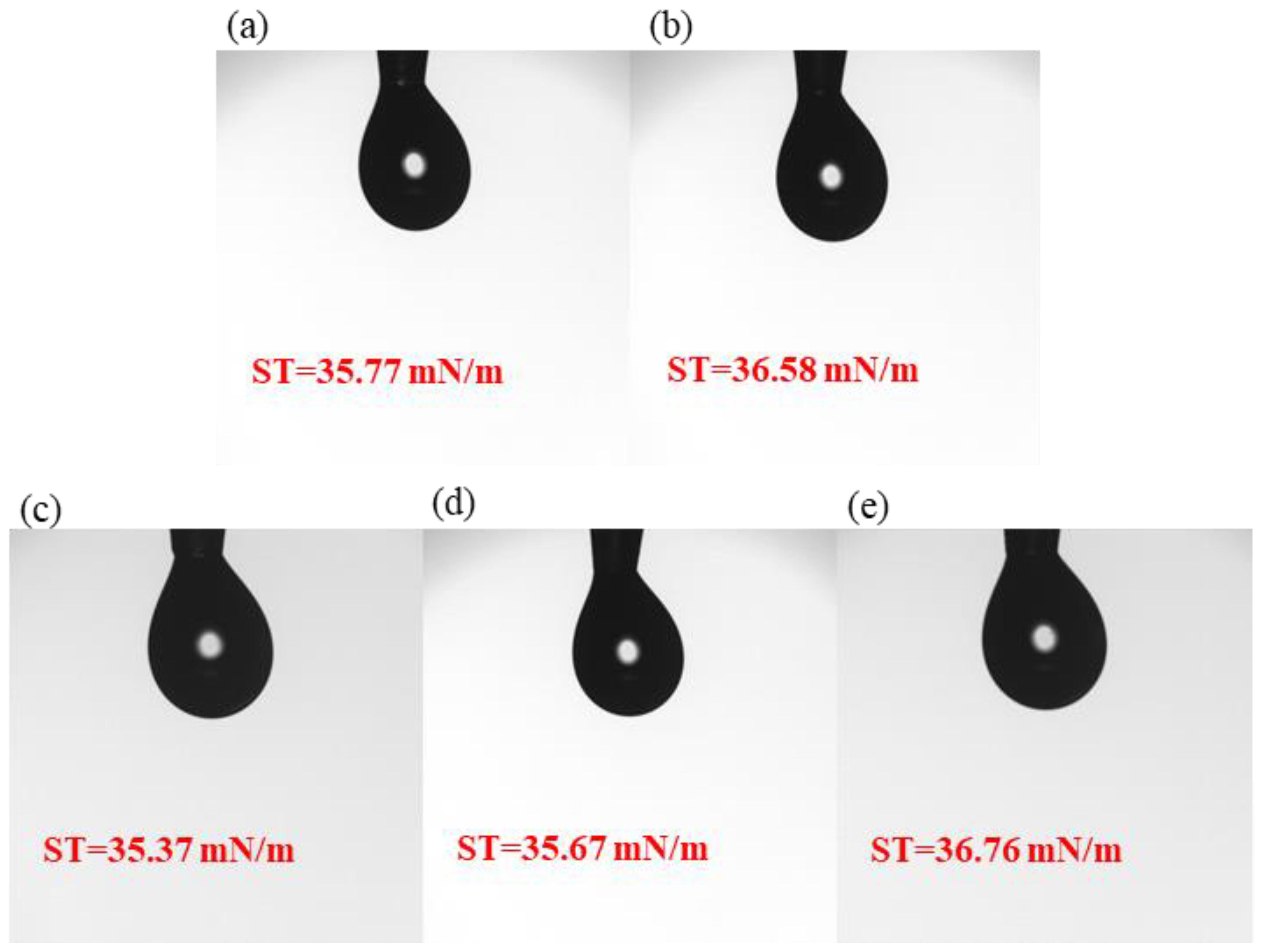

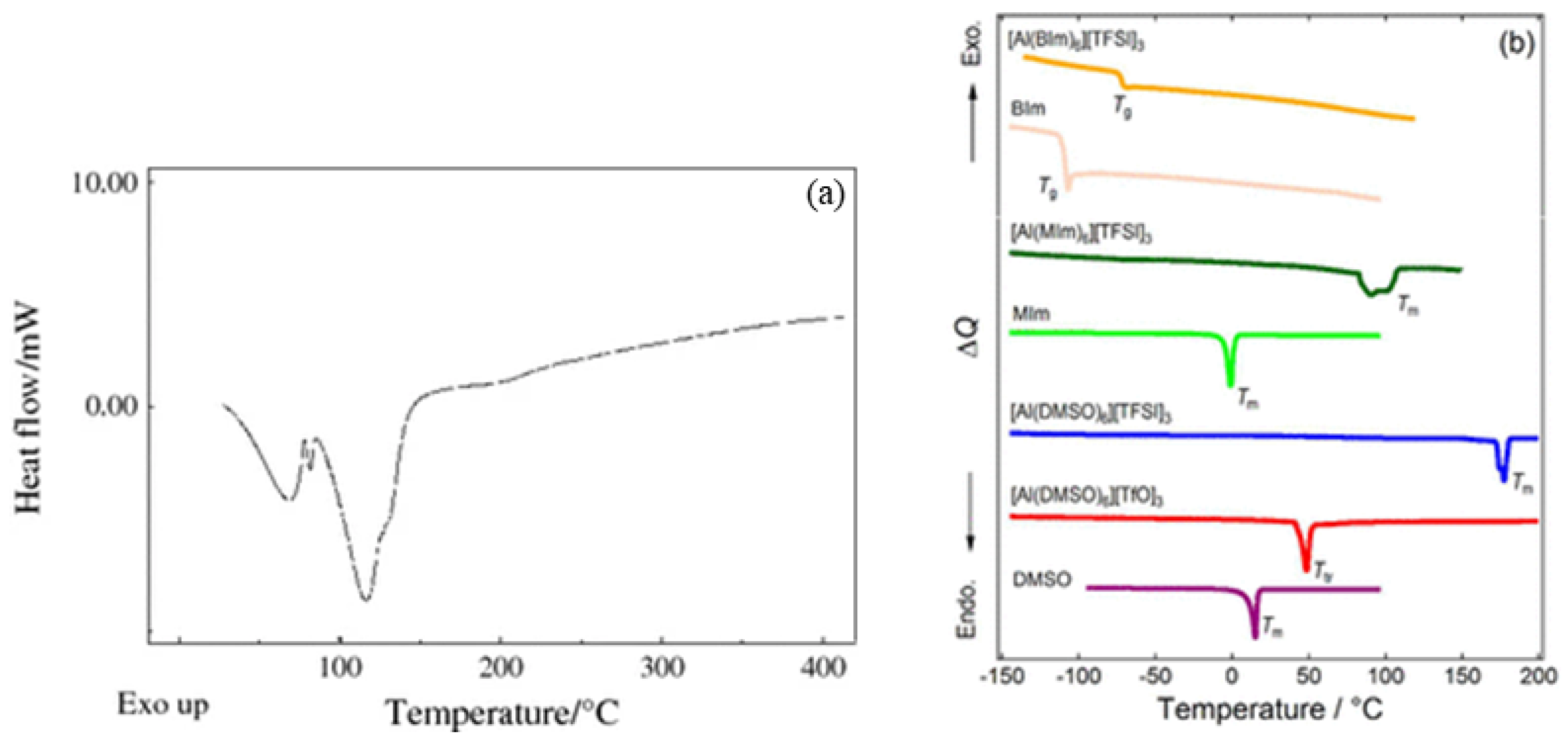

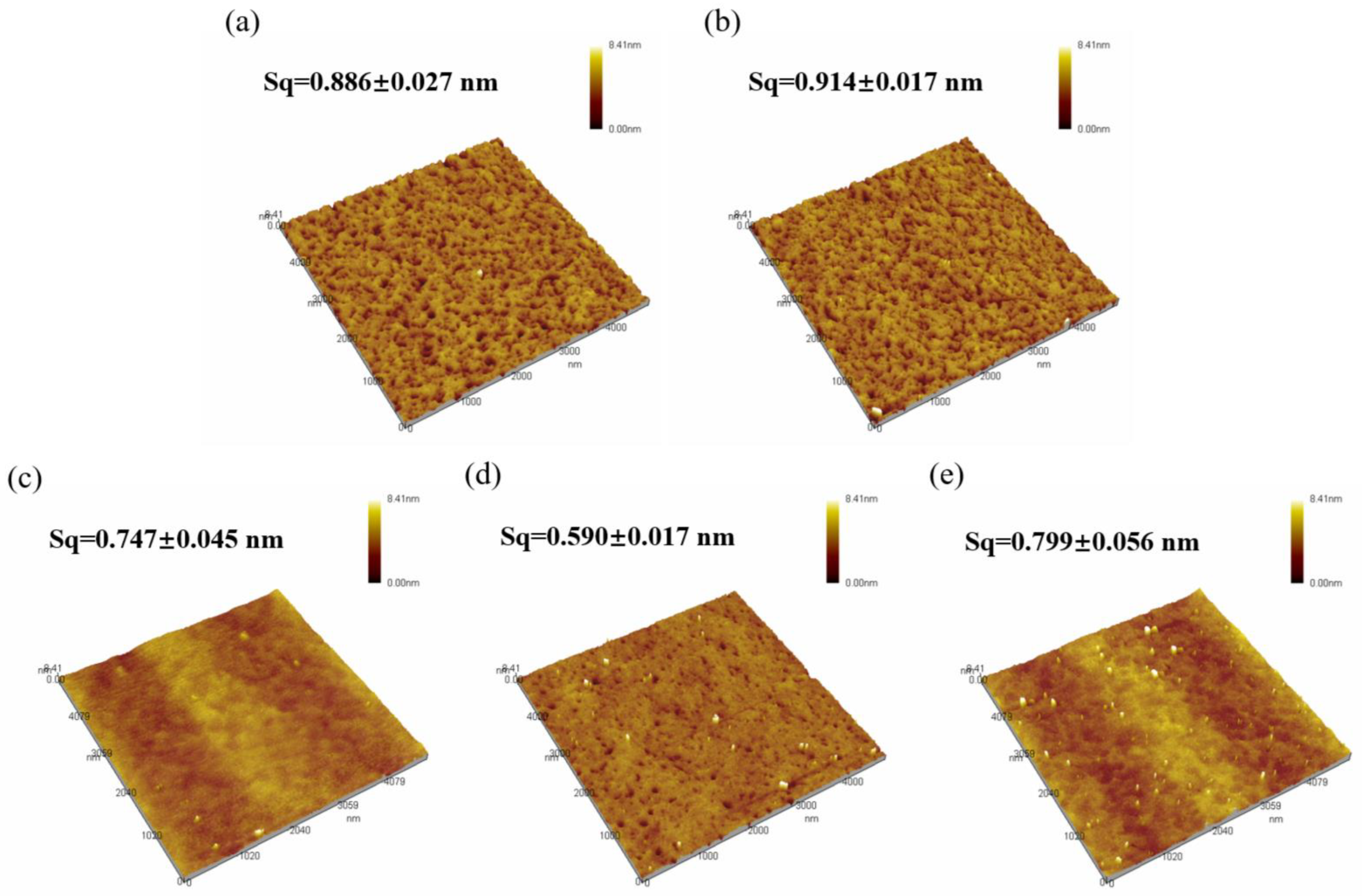
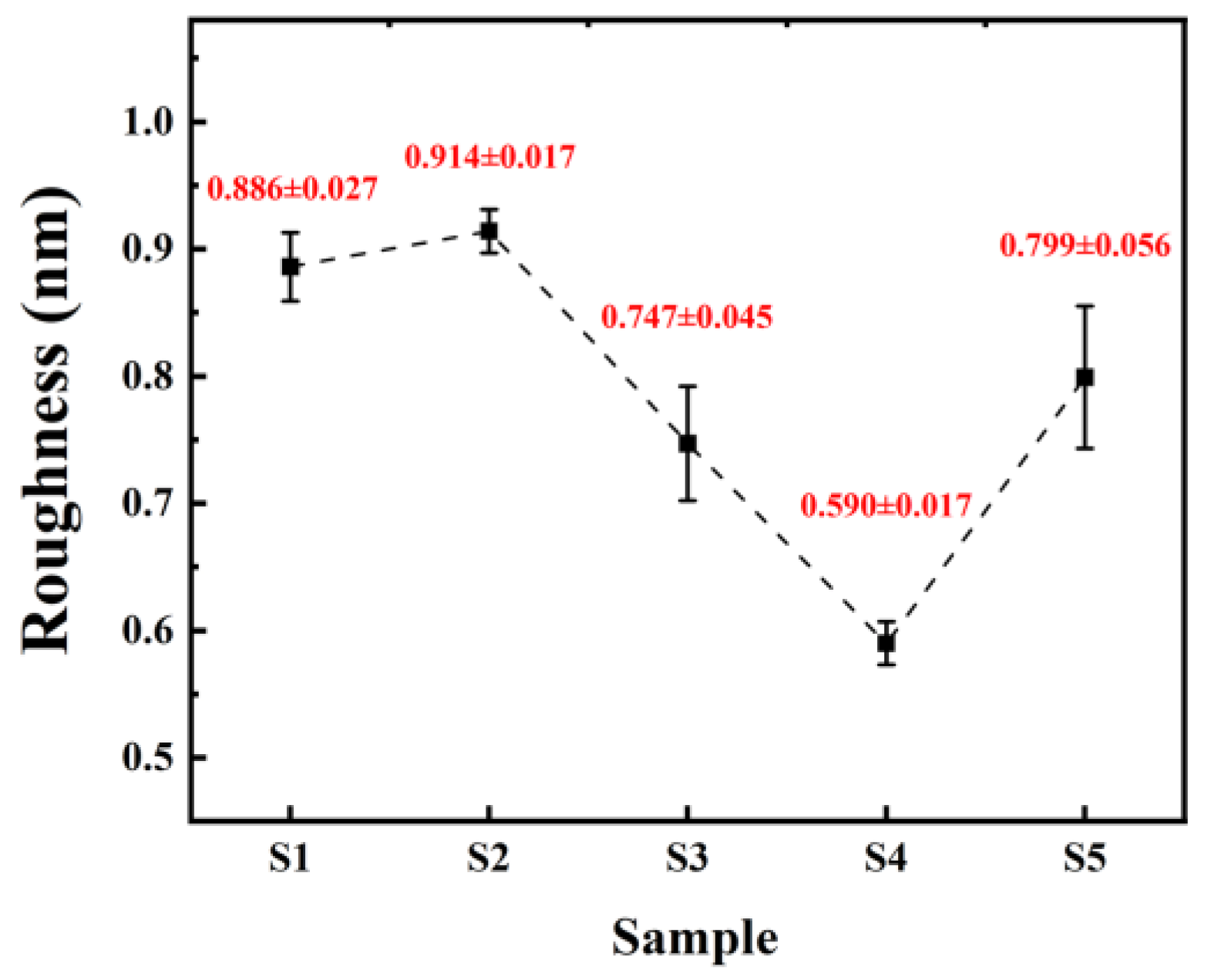
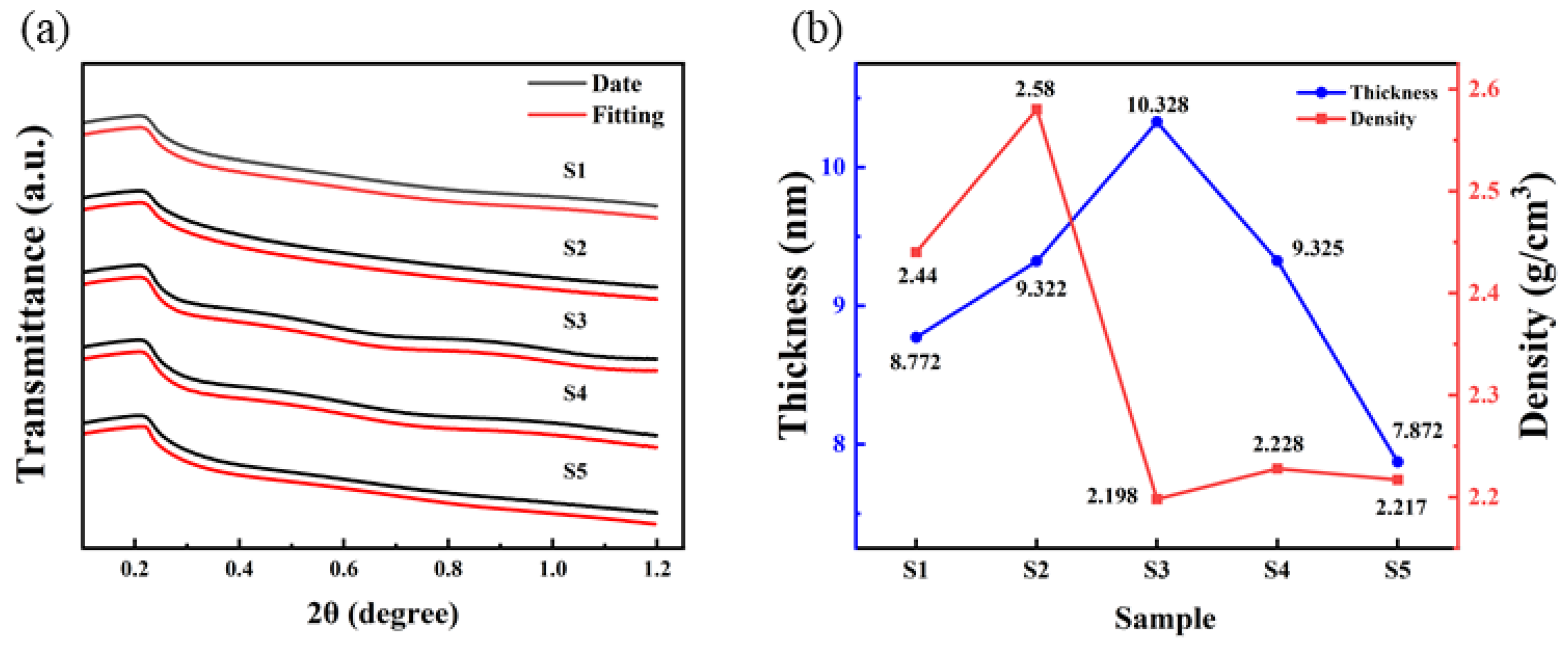


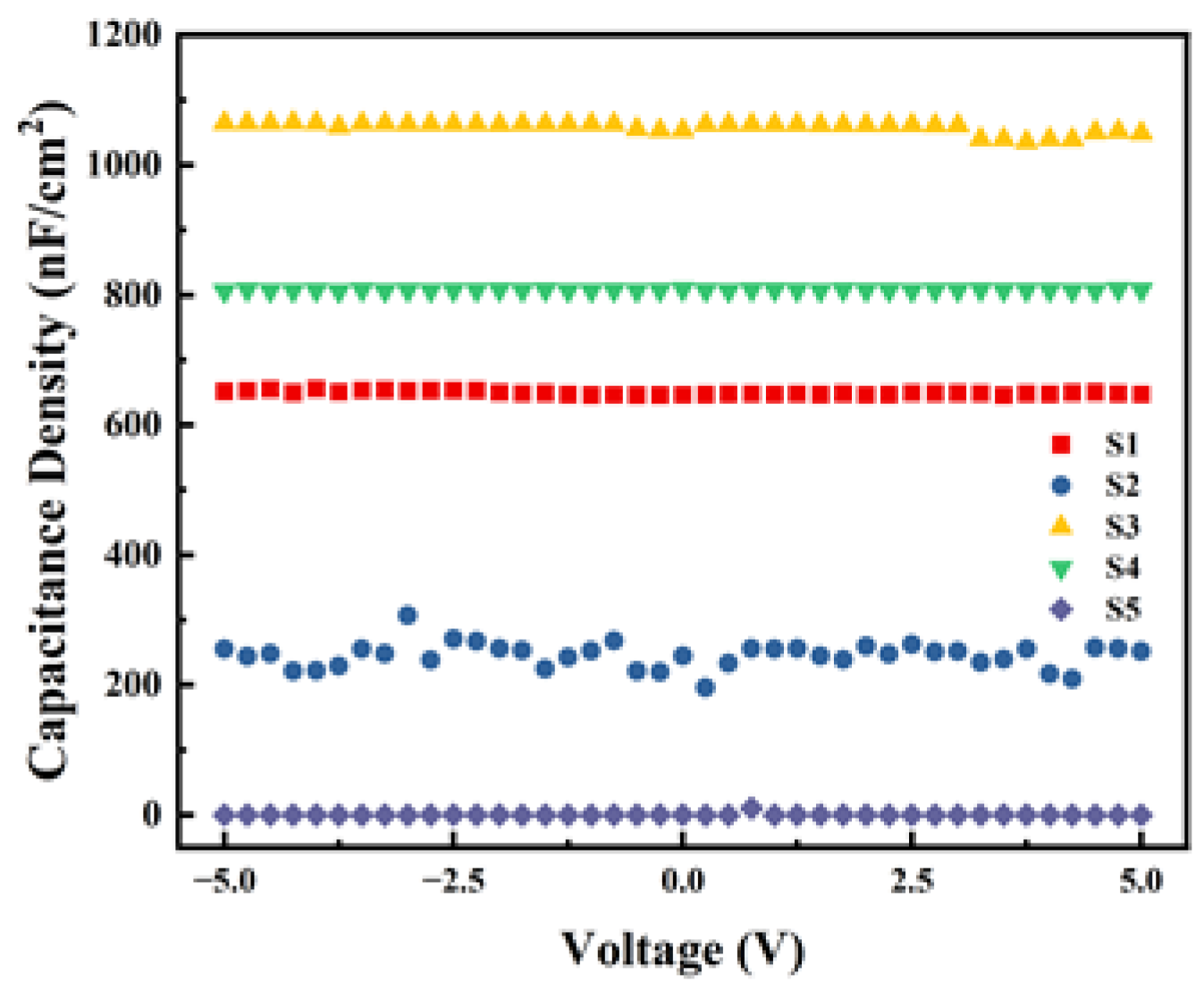

| Proportion of Precursor System Components | c(AlNO)/mol | c(AlAC)/mol | Naming |
|---|---|---|---|
| Pure AlNO | 0.2000 | 0 | S1 |
| Pure AlAC | 0 | 0.2000 | S2 |
| AlNO:AlAC = 2:1 | 0.1333 | 0.0667 | S3 |
| AlNO:AlAC = 1:1 | 0.1000 | 0.1000 | S4 |
| AlNO:AlAC = 1:2 | 0.0667 | 0.1333 | S5 |
| Dielectric Material | Preparation Method | Leakage Current Density (A/cm2) | Relative Dielectric Constant | Refs. |
|---|---|---|---|---|
| Al2O3 | self-exothermic reaction | 1.06 × 10−8 @1 MV/cm | 8.61 @1000 Hz | this article |
| Al2O3 | DUV assisted exothermic process | 2.9 × 10−7 @1 MV/cm | 8.6 @1000 Hz | [23] |
| Al2O3 | aqueous route | 4.68 × 10−9 @1 MV/cm | 8.6 @100 Hz | [24] |
| Al2O3 | infrared irradiation | 3.5 × 10−8 @1 MV/cm | 7.6 @1000 Hz | [25] |
| Al2O3/TiO2/Al2O3 (6 nm/40 nm/6 nm) | PLD | 2.03 × 10−8 @3 V | [34] | |
| Al2O3/HfO2/Al2O3 | ALD | 10−8~10−9 @1 MV/cm | 20.7 | [35] |
| Al2O3 | PEALD | 10−9 @1 MV/cm | 9.3 @100 kHz | [36] |
Disclaimer/Publisher’s Note: The statements, opinions and data contained in all publications are solely those of the individual author(s) and contributor(s) and not of MDPI and/or the editor(s). MDPI and/or the editor(s) disclaim responsibility for any injury to people or property resulting from any ideas, methods, instructions or products referred to in the content. |
© 2024 by the authors. Licensee MDPI, Basel, Switzerland. This article is an open access article distributed under the terms and conditions of the Creative Commons Attribution (CC BY) license (https://creativecommons.org/licenses/by/4.0/).
Share and Cite
Fang, X.; Ning, H.; Zhang, Z.; Yao, R.; Huang, Y.; Yang, Y.; Cheng, W.; Jin, S.; Luo, D.; Peng, J. Preparation of High-Performance Transparent Al2O3 Dielectric Films via Self-Exothermic Reaction Based on Solution Method and Applications. Micromachines 2024, 15, 1140. https://doi.org/10.3390/mi15091140
Fang X, Ning H, Zhang Z, Yao R, Huang Y, Yang Y, Cheng W, Jin S, Luo D, Peng J. Preparation of High-Performance Transparent Al2O3 Dielectric Films via Self-Exothermic Reaction Based on Solution Method and Applications. Micromachines. 2024; 15(9):1140. https://doi.org/10.3390/mi15091140
Chicago/Turabian StyleFang, Xuecong, Honglong Ning, Zihan Zhang, Rihui Yao, Yucheng Huang, Yonglin Yang, Weixin Cheng, Shaojie Jin, Dongxiang Luo, and Junbiao Peng. 2024. "Preparation of High-Performance Transparent Al2O3 Dielectric Films via Self-Exothermic Reaction Based on Solution Method and Applications" Micromachines 15, no. 9: 1140. https://doi.org/10.3390/mi15091140








